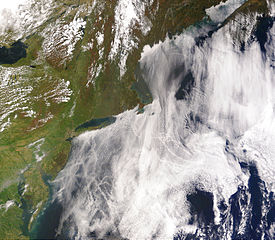In my last post, talk focused on the “climatological shift” (or climate change) and “climatological cliff” phenomena and, with reference to the latter, what going over or falling off such could mean, that is, climatologically speaking. I also pointed out why air pollution, irrespective of climate shift or cliff, is not to be taken lightly due to the threat to health that it poses. More on this to follow.
At this time, I want to draw your attention to an article that will be coming out in the January 2013 issue of Scientific AmericanTM. The article is to be called: “The Coming Megafloods,” in the printed, published version.
The article is an interesting read. Such megafloods are the result of what are referred to in the version already online as “atmospheric rivers,” enormous bands of water potentially stretching thousands of miles long and hundreds of miles across that have caused disastrous floods throughout 
California’s San Joaquin Valley, according to the authors, was “an inland sea,” a 20-mile-wide swath stretching 300 miles long. Thousands were killed.
I bring this all up because of something the authors stated which is:
“As many as nine atmospheric rivers hit California every year, according to recent investigations. Few of them end up being strong enough to yield true megafloods, but even the ‘normal’ storms are about as intense as rainstorms get in the rest of the U.S., so they challenge emergency personnel as well as flood-control authorities and water managers.
“Atmospheric rivers also bring rains to the west coasts of other continents and can occasionally form in unlikely places. For example, the catastrophic flooding in and around Nashville in May 2010—which caused some 30 deaths and more than $2 billion in damages—was fed by an unusual atmospheric river that brought heavy rain for two relentless days up into Tennessee from the Gulf of Mexico. In 2009 substantial flooding in southern England and in various parts of Spain was also caused by atmospheric rivers. But the phenomenon is best understood along the Pacific Coast, and the latest studies suggest that these rivers of vapor may become even larger in the future as the climate warms,” article authors Michael D. Dettinger and B. Lynn Ingram noted.
And it is just this kind of information that may warrant continued close observation regarding such atmospheric events from within the climatologic and scientific communities in particular.
Since it has been about 150 years since the 1861-‘62 megaflood occurred, one has to wonder when the next “big one” will happen.
And considering the 2009 and 2010 episodes, and after reading this article, I can’t help but wonder if we’ll be seeing more of these kinds of events or if air pollution is prompting temperature rise and if such rise could be a contributing factor.
I already know what kind of damage a hurricane can inflict. I was in one: Hurricane Agnes, in 1972, in Baltimore, Maryland. That was pretty devastating. But nothing near what a megaflood can leave in its destructive wake, apparently.
Image above: NASA
– Alan Kandel